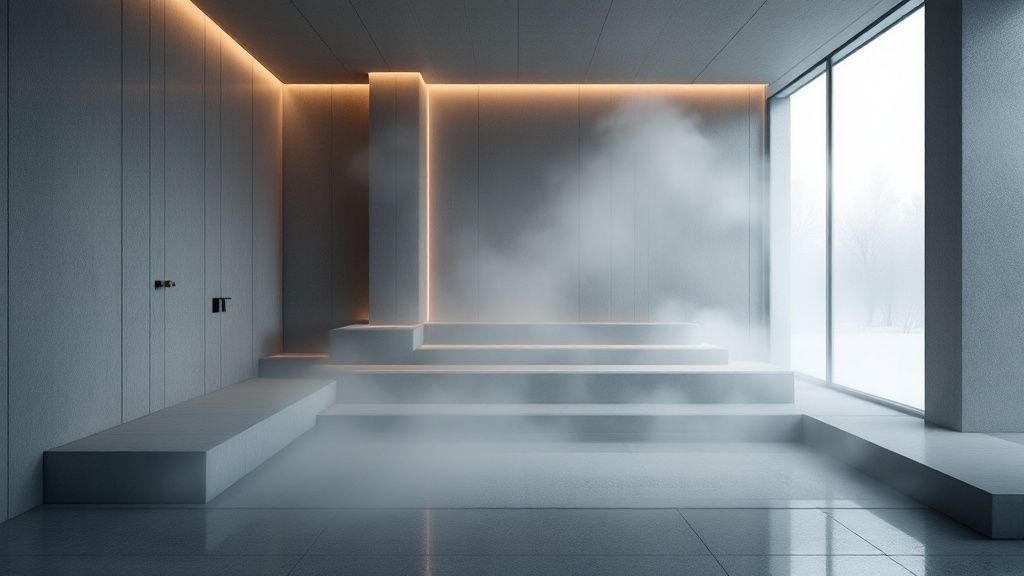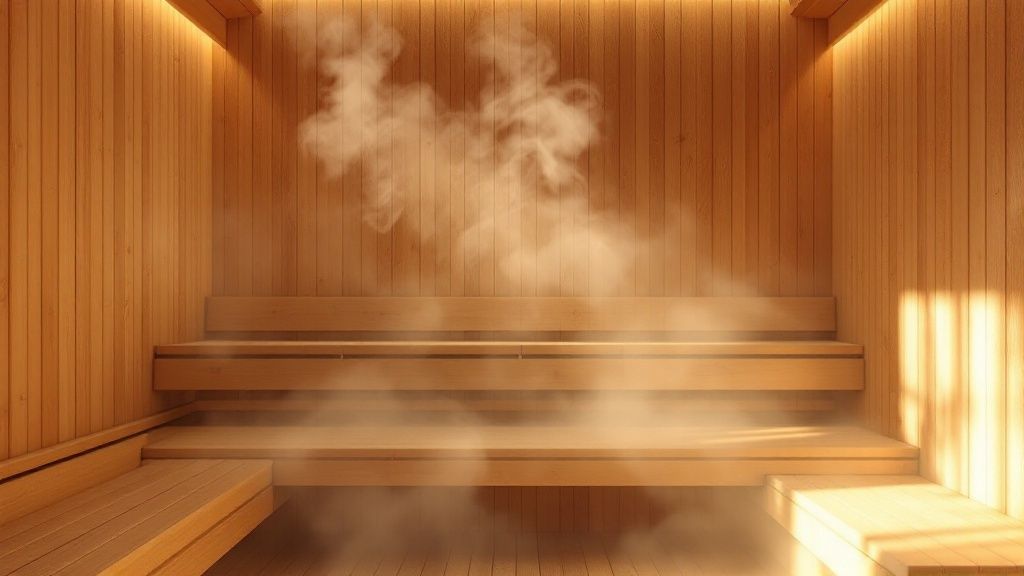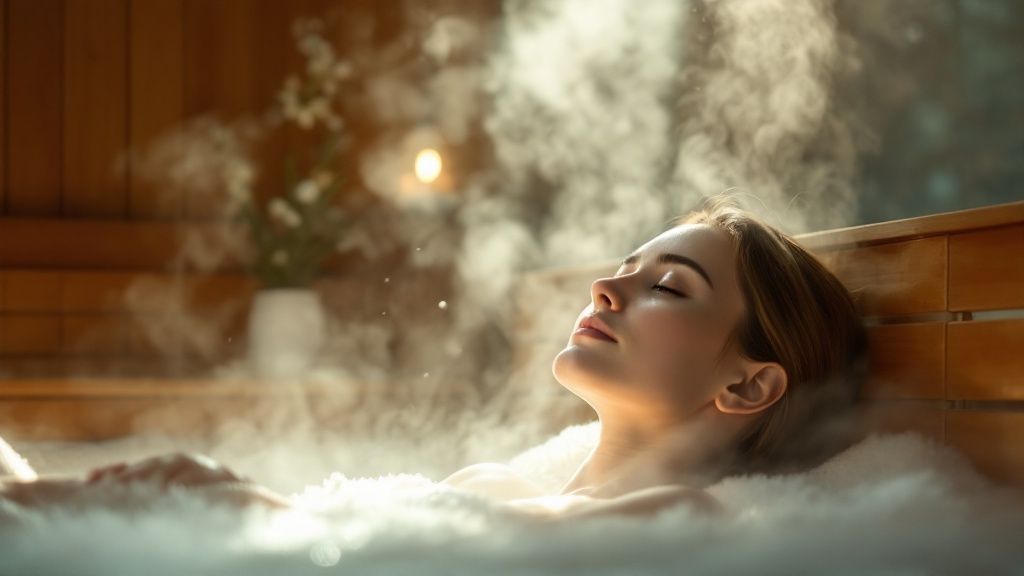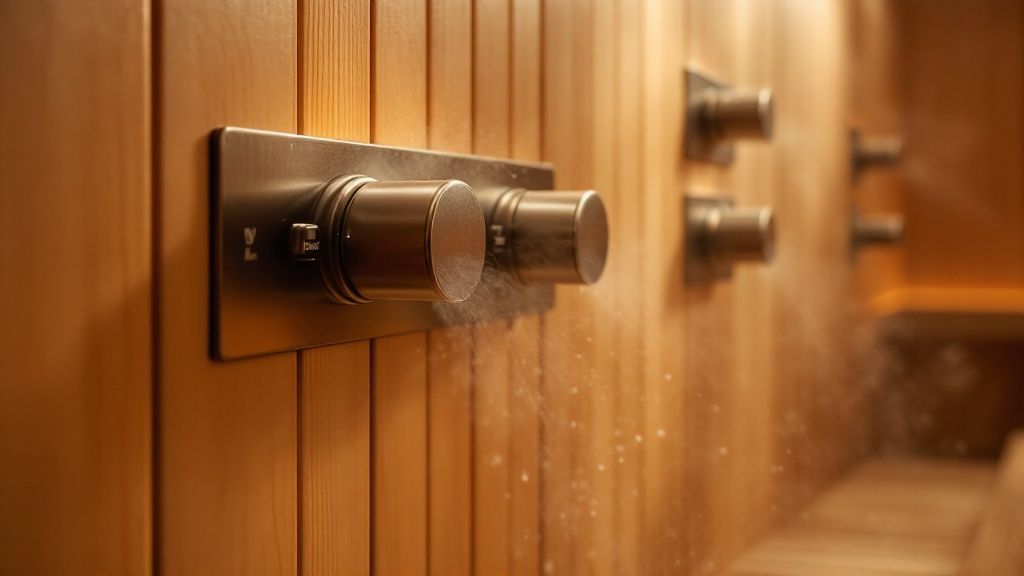Transform Your Well-Being with a Steam Sauna Room
- Sauna Tracker

- Apr 1
- 11 min read
The Science Behind Steam Sauna Rooms

Steam rooms offer a distinct wellness experience compared to dry saunas. These humid environments use steam to create therapeutic benefits. Understanding how steam is generated, the ideal temperature and humidity balance, and their impact on well-being is crucial.
How Steam is Generated
At the heart of a steam room is the steam generator. This device boils water and releases the resulting steam into the enclosed space. The steam, at 100% humidity, saturates the air, creating a dense, warm fog. This differs significantly from a traditional sauna's dry heat. Maintaining a comfortable temperature, typically between 110°F and 120°F (43°C - 49°C), is essential for a beneficial experience. This lower temperature compared to a traditional sauna allows for longer sessions and deeper relaxation.
The Importance of Humidity and Temperature
High humidity is key to a steam room's therapeutic effects. Moist heat penetrates the skin more effectively than dry heat, increasing perspiration and potentially aiding detoxification. The warm, humid air also soothes and opens airways, potentially offering relief to those with respiratory concerns. For more on saunas and wellness, you can explore our blog post sitemap.
Components of a Steam Sauna Room
Several components work together to create a functional steam room. These include:
Control systems: These regulate temperature and session duration for a consistent, personalized experience.
Seating: Often made of tile or teak, seating is designed for comfort and durability in the humid environment.
Ventilation: Essential for preventing moisture buildup and mold growth.
Enclosure materials: Tile or glass are common choices due to their moisture and heat resistance.
Investing in a steam room, whether for home or commercial use, shows a dedication to wellness. The global steam rooms market, currently valued at USD 0.28 billion (2023), is projected to reach USD 0.42 billion by 2032, with a CAGR of 3.7%. This growth is fueled by the increasing popularity of spas and wellness centers, alongside the recognized health benefits of steam rooms. Key industry players include Steamist, Mr. Steam, and Amerec, often part of larger sauna and steam technology companies. More detailed market statistics can be found here. Understanding the science behind steam rooms helps you make informed decisions, choosing a system that meets your needs and offers lasting value.
Transform Your Health With Steam Sauna Therapy

Beyond simple relaxation, the steam sauna room offers numerous health benefits. Unlike dry saunas, the moist heat penetrates tissue differently, offering unique advantages. This can lead to improvements in everything from breathing to skin health.
Physiological Responses to Steam Therapy
During a steam sauna session, your body experiences several beneficial physiological changes. The moist heat causes vasodilation, widening blood vessels and improving circulation. This increased blood flow delivers more oxygen and nutrients throughout the body.
Steam therapy also promotes sweating. This can improve detoxification by removing metabolic waste products through the skin. The relaxing environment can also reduce stress hormones like cortisol.
Optimizing Your Steam Sauna Experience
To get the most out of steam therapy, consider these factors:
Session Duration: Start with 15-20 minutes, especially if you're new to steam saunas. Experienced users can gradually increase the duration.
Frequency: 2-3 sessions per week is a good starting point for general wellness. Adjust this based on your goals and tolerance.
Hydration: Drink plenty of water before, during, and after your session to replenish lost fluids.
Targeting Specific Health Goals
Steam sauna therapy can be used to address specific health needs. The moist heat can open airways and loosen congestion, benefiting those with allergies or sinus issues. Increased sweating can cleanse pores and improve skin tone, rejuvenating your skin. You can learn more tips and techniques from resources like SaunaTracker.
The following table summarizes the key differences and similarities between steam sauna rooms and traditional dry saunas:
Steam Sauna Room Health Benefits Comparison: A comprehensive comparison of health benefits between steam sauna rooms and traditional dry saunas
Health Benefit | Steam Sauna Room | Traditional Dry Sauna |
|---|---|---|
Respiratory Relief | Opens airways, loosens congestion | Can also help with congestion, but drier air may be less effective |
Skin Rejuvenation | Cleanses pores, improves skin tone | Dries skin, may exacerbate some skin conditions |
Detoxification | Promotes sweating to eliminate waste | Promotes sweating, but dry heat may be less effective for some |
Cardiovascular Health | Improves circulation through vasodilation | Improves circulation, may lower blood pressure |
Relaxation | Reduces stress hormones | Reduces stress hormones |
Muscle Recovery | Can soothe sore muscles | Can soothe sore muscles |
This table highlights how both sauna types offer benefits, but the moist heat of a steam room provides advantages for respiratory issues and skin health. While both promote detoxification and relaxation, the moist heat of a steam room may be more effective for some.
The sauna and spa market, including steam rooms, is projected to reach USD 208.99 billion by 2030. This represents a CAGR of 7.43% from 2023 to 2030, with Europe leading the growth. HomeInDepth provides more market statistics. Factors driving this growth include increased demand for wellness services and the rise of smart sauna technology. By understanding the science behind steam therapy and customizing your sessions, you can use steam to improve your overall health.
Designing Your Dream Steam Sauna Sanctuary

Bringing your dream steam sauna to life starts with careful planning. Think of it as a journey, from the initial blueprints to choosing the perfect materials and ensuring proper ventilation. Skipping these key steps can lead to expensive fixes later on.
Space Allocation and Material Selection
First, determine the best size and spot for your steam sauna. A small nook might work for a compact steam shower, while a dedicated area could house a larger, more luxurious setup. The size of your steam generator will play a significant role in determining the overall dimensions.
Choosing the right materials is crucial in such a humid environment. Moisture-resistant materials like tile, glass, and teak wood are excellent options for walls, benches, and flooring. These materials can handle the damp conditions, ensuring your sauna stays beautiful and functional for years to come. Don't forget proper insulation behind the finishes to protect against moisture damage and boost energy efficiency. You may find additional information in our blog category sitemap.
Ventilation and Architectural Elements
Good ventilation is essential to prevent mold and mildew. A correctly sized exhaust fan and well-placed vents are key to maintaining consistent airflow. A slightly sloped floor leading to a drain will also prevent water from accumulating.
Beyond the practical aspects, consider design elements that enhance the experience. Innovative lighting, thoughtfully placed benches, and the incorporation of natural elements can create a truly relaxing atmosphere. Dimmable LED lights can set a soothing mood, while a small window with a garden view adds a touch of tranquility.
Working With Contractors and Market Trends
When you're ready to build, hiring experienced contractors is a must. They need to understand the specifics of steam environments, including proper sealing and waterproofing. Their expertise will ensure a smooth installation and avoid problems caused by faulty construction. This also includes the electrical work, which needs to meet safety regulations for wet locations.
The increasing interest in steam saunas reflects a broader wellness trend. The global sauna market, including steam saunas, was valued at USD 859.5 million in 2023. It's expected to reach USD 1.27 billion by 2030, growing at a CAGR of 5.9%. This growth is driven by a greater awareness of health benefits, rising disposable incomes, and advancements in sauna technology. Steam saunas, within this expanding market, are benefiting from the demand for holistic wellness and at-home spa experiences. Find more detailed statistics here. With careful planning and informed decisions, your steam sauna can become a cherished addition to your home, offering lasting wellness benefits.
Home Vs. Commercial Steam Sauna Rooms: Making The Right Choice

Selecting the perfect steam sauna involves understanding the distinct needs of home and commercial environments. From the initial price tag to daily upkeep, each setting has unique considerations. Making the right choice ensures a smart investment that aligns with your wellness goals. Thinking about your overall bathroom design is important when planning your steam sauna. Badezimmer might offer some helpful design inspiration.
Initial Investment And Long-Term Costs
Residential steam sauna rooms generally have lower upfront costs compared to commercial installations. This is often due to smaller sizes and simpler features. Long-term maintenance can often be handled by homeowners, potentially reducing the need for costly professional services.
Commercial steam sauna rooms, however, demand a more significant initial investment. Built to withstand heavier use and accommodate more people, they require robust components and advanced features. Think multiple shower heads, aromatherapy systems, and more. While the upfront cost is higher, preventative maintenance contracts can help ensure smooth operation and minimize downtime, protecting your investment.
Maintenance Requirements And ROI
Residential steam sauna maintenance is typically straightforward, involving regular cleaning and periodic checks of key components like the generator and control systems. A well-maintained home sauna can be a valuable asset, potentially boosting property value and offering daily wellness benefits.
Commercial saunas, due to their higher usage, demand more frequent and intensive care. This includes daily cleaning, regular deep cleans, and professional servicing of the generator, control panel, and other essential components. For businesses, understanding these maintenance needs is essential for maximizing return on investment (ROI).
Usage Patterns And Business Models
Home steam saunas offer a personalized wellness experience, allowing users to tailor sessions to their individual needs and preferences. This flexibility seamlessly integrates steam therapy into a daily routine.
Commercial steam rooms, designed for high traffic, require design considerations that meet the needs of diverse users. A boutique wellness center might prioritize a luxurious experience with premium materials, while a hotel may opt for durable, easy-to-clean features to serve numerous guests. Analyzing usage patterns and aligning them with the appropriate business model is critical for a successful commercial steam sauna operation. Check out our blog category sitemap for additional insights.
To help illustrate the key differences, let's look at a detailed comparison:
Residential vs. Commercial Steam Sauna Room Comparison
A detailed comparison of factors to consider when choosing between residential and commercial steam sauna installations.
Factor | Residential Installation | Commercial Installation |
|---|---|---|
Initial Investment | Lower | Higher |
Maintenance | DIY, less frequent | Professional, more frequent |
Usage | Personal, flexible | High traffic, diverse needs |
Features | Simpler | More advanced |
ROI | Increased property value, personal wellness | Business profitability |
Cleaning | Less frequent | Daily, deep cleans required |
Durability | Moderate | High |
This table highlights the core differences between residential and commercial steam sauna installations, emphasizing the need to align your choice with your specific circumstances. Residential installations prioritize affordability and personal use, while commercial installations require a higher investment and focus on durability and serving a larger number of users.
Market trends indicate a growing demand for both residential and commercial steam saunas. Traditional saunas hold a significant market share, but infrared and electric saunas are gaining popularity. The residential segment is expected to expand considerably, driven by home renovation trends and the increasing desire for private relaxation spaces. More detailed statistics on market growth can be found here. This demand is further supported by customizable and space-saving sauna solutions, many with steam features. By understanding these market dynamics and comparing residential and commercial options, you can make a well-informed decision that meets your needs and goals.
Essential Maintenance Secrets for Steam Sauna Room Longevity
Maintaining your steam sauna room properly is crucial for its longevity and optimal performance. Think of it like caring for a car: regular maintenance prevents costly repairs in the future. This applies to both residential and commercial steam sauna rooms. Proper care also ensures a hygienic and enjoyable sauna experience every time.
Cleaning Regimens for a Hygienic Sauna
Regular cleaning prevents bacterial growth and keeps your steam sauna room sparkling. After each use, wipe down the benches, walls, and floor with a mild disinfectant cleaner designed for sauna use. This removes sweat, body oils, and other residues. A simple solution of water and white vinegar can effectively clean many surfaces.
Deep clean your steam sauna at least once a month. This involves scrubbing the surfaces with a stronger cleaner and removing any mineral deposits. This prevents grime buildup and ensures a sanitary environment.
Early Warning Signs and Troubleshooting
Identifying potential problems early can save you time and money. Pay attention to changes in steam quality. A decrease in steam output could indicate a generator problem. Unusual sounds, like grinding or rattling, can also signal potential equipment issues.
You can troubleshoot some minor problems yourself. Our sitemap offers more resources on sauna maintenance. However, contact a qualified technician for complex issues. Attempting complicated repairs yourself could worsen the problem and void warranties.
Water Quality Management and Ventilation
The water used in your steam generator directly impacts its lifespan. Hard water, with high mineral content, can lead to scale buildup inside the generator, reducing its efficiency and causing damage. Installing a water softener or using distilled water can extend the life of your steam generator.
Proper ventilation is also essential. Adequate airflow prevents moisture buildup, which can lead to mold and structural damage. Ensure your sauna has a functioning exhaust fan and vents. Regularly inspect and clean these components to ensure they’re working effectively.
Seasonal Maintenance and Professional Help
Your steam sauna benefits from seasonal maintenance. Before winter, inspect the insulation and sealing. This helps maintain a consistent temperature inside and reduces energy consumption. In the summer, check the ventilation system, especially in humid climates.
While you can handle many maintenance tasks yourself, some situations require professional assistance. If you notice a significant decrease in steam output or unusual noises from the generator, contact a qualified technician. They have the expertise to diagnose and repair complex problems, ensuring your steam sauna provides years of enjoyment.
Selecting Steam Sauna Technology That Actually Delivers
Choosing the right technology for your steam sauna can be a daunting task. Marketing hype often makes it difficult to discern the truly important features. This guide provides clear and concise advice for selecting a steam sauna system that offers lasting value.
Decoding Generator Power and Control Systems
The steam generator is the core of your steam sauna. Its power rating, measured in kilowatts (kW), dictates how quickly and efficiently steam is produced. A higher kW rating generally translates to faster heating and a more consistent steam output, particularly in larger rooms.
Control systems regulate temperature, humidity, and session length. Basic models offer simple on/off switches, while more advanced systems offer programmable settings, remote control through smartphone apps, and even integration with smart home platforms. Think about your needs and preferences. Do you prioritize precision and customization, or is a simple system more your style?
Material Quality and Component Longevity
The lifespan of your steam sauna depends heavily on the quality of its components. Prioritize corrosion-resistant materials such as stainless steel for generators, and durable, moisture-resistant materials like tile and teak for the interior. Higher-quality components might have a higher upfront cost, but offer long-term savings by minimizing repairs and replacements.
Different manufacturers employ varying engineering approaches. Research various brands, comparing warranties and customer reviews to gauge their reliability. This research will ensure your investment endures.
Smart Home Integration and Emerging Technologies
Technology is reshaping the steam sauna experience. Smart home integration lets you control your sauna remotely, preheating it before you get home or adjusting settings from your phone. Some systems offer customized therapy programs, tailoring the experience to your wellness goals. Features like voice control and mobile monitoring add further convenience and personalization.
While these advanced features are attractive, consider your needs and budget. Some prefer the simplicity of a traditional steam sauna, while others embrace innovation. Understanding your priorities will help you choose the technology that best enhances your wellness.
The steam sauna market is experiencing significant growth. The global sauna market, encompassing steam saunas, was valued at USD 859.5 million in 2023 and is projected to reach USD 1.27 billion by 2030, growing at a CAGR of 5.9%. This growth is driven by factors like increased awareness of health benefits, rising disposable incomes, and advancements in sauna technology. Learn more about the sauna market. Steam saunas, within this expanding market, are benefiting from the growing consumer interest in wellness and at-home spa experiences.
Looking to optimize your sauna experience? Sauna Tracker might be a useful tool. This app, available for iPhone and Apple Watch, helps you track your sauna usage, monitor health metrics like heart rate and calories burned, and reach your wellness goals. Check out Sauna Tracker.

.png)
